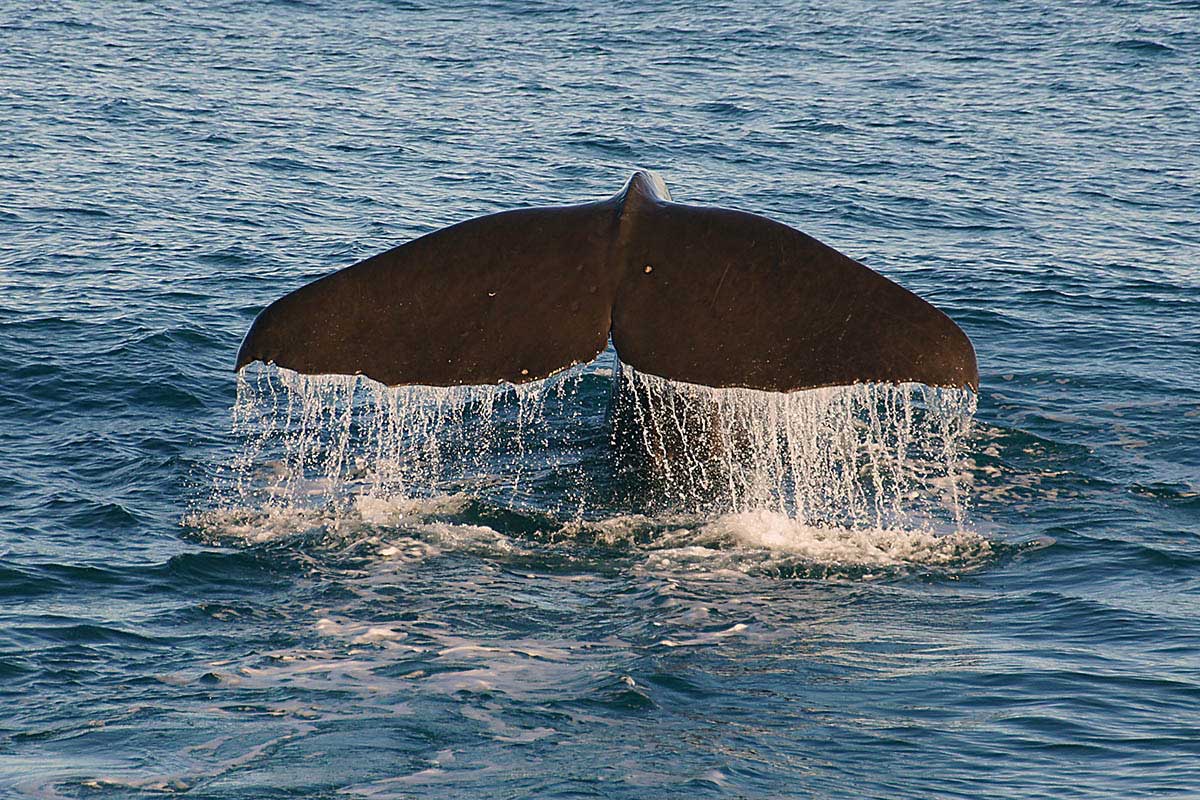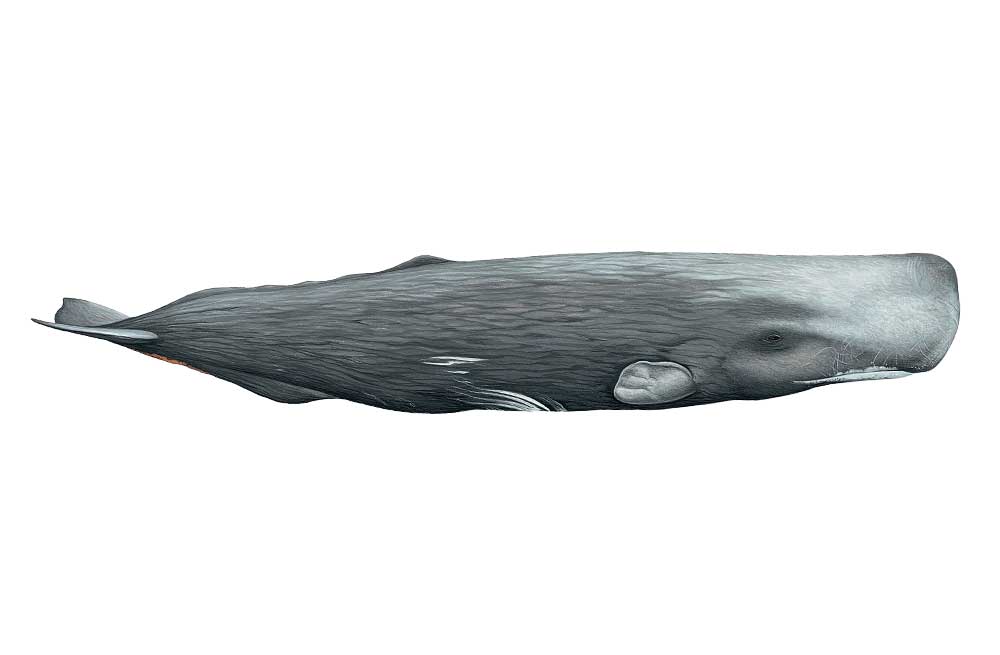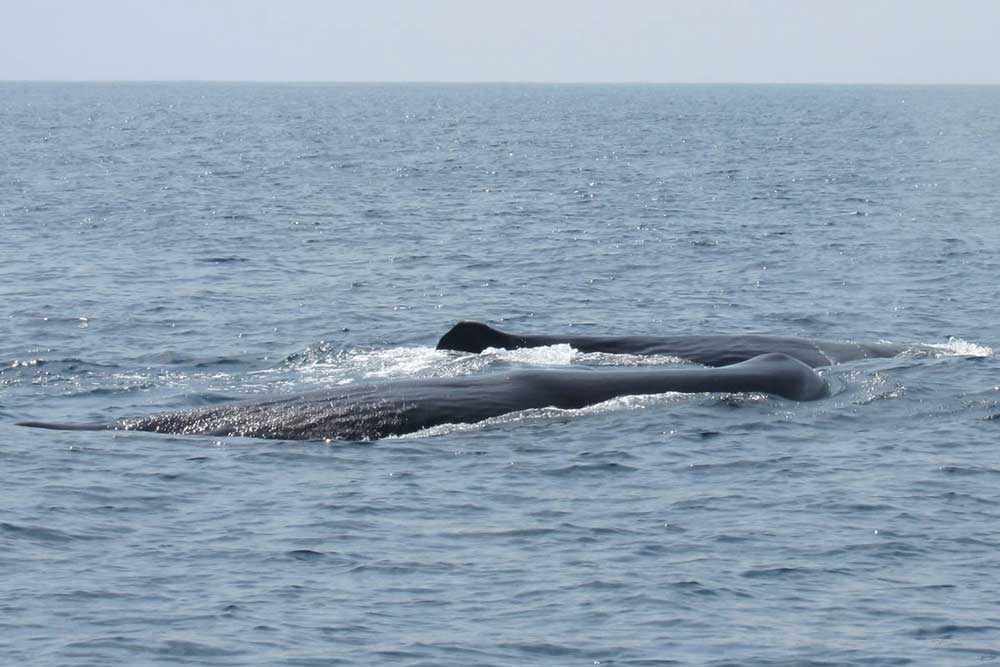
Latin: Physeter macrocephalus
Gaelic: Muc-mhara spùtach
CETACEAN FACTFILE:
Months: January – December
Length: Up to 18 metres
Range: Global distribution, except for extreme polar regions
Threats: Pollution, acoustic disturbance, entanglement in fishing gear
Diet: Variety of squid, octopus and cuttlefish
PHYSICAL DESCRIPTION
The sperm whale is the largest of the toothed whales. Males can grow to 18 metres in length, whilst females can reach about 11 metres. On top of the head, the s-shaped blowhole is positioned to the left and angled forward, which produces a distinct, angled bushy shaped blow. Sperm whales do not have a true dorsal fin but there is a small triangular hump, behind which a row of bumps extend along the back towards the fluke. The fluke often has nicks and notches that can be used to identify individual animals. Their skin is wrinkled and dark grey or brown in colour, with white patches on the underside and circular scars along the body caused by squid suckers. The large, square shaped head represents about one-third of the total body length and contains the spermaceti organ; this organ is filled with a waxy liquid called spermaceti, which is involved in sound production and echolocation. The lower jaw is narrow and contains 20 to 26 pairs of conical teeth, which fit into sockets in the top jaw, where there are no teeth.
BEHAVIOUR
Sperm whale social structure involves groups of females with their young male offspring, bachelor herds of juvenile males and solitary adult males. Sightings in the Hebrides are normally of solitary animals. When feeding, sperm whales make long dives as deep as 2,500 metres for up to two hours, and often return to the same place on the surface. A diving sperm whale characteristically arches its back and raises its tail fluke. Sperm whales can be seen ‘logging’ at the surface between dives, which is where they float motionless at the surface whilst resting. Sound is very important to sperm whales, as they use echolocation for navigation and to locate food in the dark ocean depths. Males also produce very loud vocalisations, known as ‘clangs’, which are believed to be a mating display. There are several records of stranded sperm whales around the British coast, including the Hebrides.
HABITAT AND DISTRIBUTION
Sperm whales have a global distribution, although it is thought that only adult males occur in the polar regions. They are mainly associated with deep water, which harbours their preferred prey, squid, and are commonly found over submarine canyons and continental shelf regions. The UK has the highest number of sperm whale sightings in Northern Europe; but sperm whale sightings are very rare in the Hebrides, with just one or two reports every year, because they prefer the deeper waters beyond the Outer Hebrides.
FOOD AND FORAGING
From analysing stomach contents, scientists know that sperm whales can feed on up to 40 different species of squid, octopus and cuttlefish, and most famously dive to incredible depths to hunt giant squid, which measure up to 12 metres long. Their bodies often bear scars inflicted by the squid's’ suckers and beak. In a single day, an adult sperm whale can eat as much as one ton of squid, but they also feed on some fish and crustaceans.
STATUS AND CONSERVATION
Sperm whales were once the target of commercial whalers because of the valuable spermaceti oil inside their heads, which was used to make candles. Populations were depleted during this time, but currently this species appears to be relatively abundant in all oceans. Current threats include the accumulation of toxic pollutants such as organochlorides in the whales’ tissue and organs, entanglement in fishing nets and marine litter, and noise disturbance, which interferes with their complex echolocation and use of sound.



